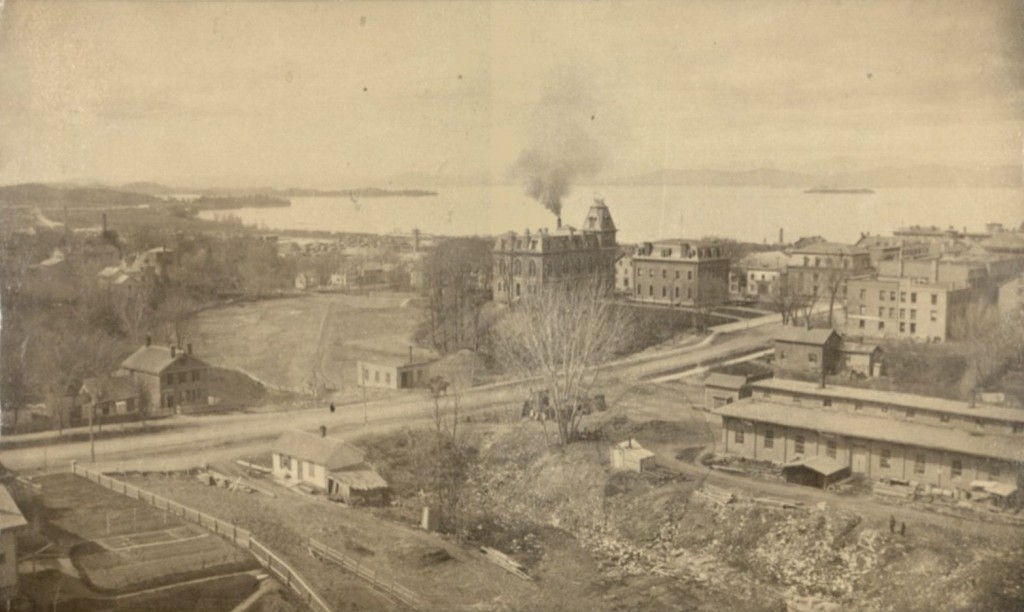Since 2002, shoppers have been buying groceries at Onion River Co-op’s City Market on South Winooski Avenue in Burlington, Vermont. The store is very successful, with over 11,000 members/owners and thousands of shoppers every day. Prompted by a photo in our Burlington photograph collection, I recently investigated the short history of Burlington’s first city market, also located on South Winooski Avenue, and found that it did not fare as well.
The city purchased land for a market before 1865, but progress was slow. In his 1867 annual report, Mayor Wales acknowledged that there was disagreement about the need for a public market, but he felt that once established it would be a great blessing, and urged the alderman to experiment in a prudent way. The following year, Mayor Ballou was more blunt, saying that the city should move on the market or sell the land.

The City Market lot east of White Street (now Winooski Avenue) between College and Main Streets can be seen in this section from an 1869 map.
Although Ballou didn’t mention the market in his 1869 report, the aldermen had chosen to move. On December 3, 1869, the Burlington Free Press announced that the city market building was nearly completed and ready for occupancy. The announcement provides a good description of the site, the building, and the first vendors.
The new market site and its surrounding grounds were created by an ambitious program to fill a deep hollow that ran through the growing city center. The newspaper anticipated that more filling would be undertaken to make room for vendors and customers.
The brick building, one of many designed by master carpenter and contractor Elmore Johnson, was 104 feet long and 51 feet wide. A deck above the roof provided light and ventilation. Stalls lined both sides of a 14-foot wide main hall. A second hall ran east-west through the center of the building. The 12 x 18 foot stalls were separated by 7-foot partitions. Each stall had a sliding door and a cellar under it. The building was lighted with gas, and water came from the city aqueduct. All of the stalls had been rented. Eight were devoted to meat, several to groceries and general merchandise, one to fish, and one to refreshments.

City Market is the long brick building in the lower right. Main Street runs through the center of the photo, which was taken between 1882 and 1887. The ravine east of the market was still being filled.
Shortly after the building was completed, the city council passed a city market ordinance that established rules for its operation and created the position of superintendent of markets to manage the market and collect rent. In his 1870 annual report, Mayor D. C. Linsley was optimistic about the market’s future. The following year, Mayor L. C. Dodge proclaimed that while he had not originally supported the market, the city needed to make it successful.
In February 1870, the Burlington Free Press acknowledged that produce sellers were beginning to appreciate the market. At least one vendor, “Berry Man” Joseph Chauvin, did exceptionally well. In the summer of 1871, he sold 9,500 quarts of blueberries, strawberries, raspberries, and blackberries, and the following summer, he sold an astonishing 14,400 quarts of blueberries.
Unfortunately, merchants preferred the growing downtown to the west, and the stall rents collected by Superintendent F. Smith failed to cover market expenses. In his 1872 annual report, Mayor Dodge complained about the “very unsatisfactory state of affairs.” He told the city council that it was time to “kill or cure.” Their cure involved leasing the market building. In October 1873 the market ordinance was repealed, and after an initial rental failed, local attorney and businessman Levi Underwood leased the market building for ten years. His plans must not have succeeded, because by the early 1880s, one observer noted that the market had grown “into disfavor, was abandoned, and now stands unoccupied.”
For the next several decades, city departments used the building for storage and work space. The city market grounds also included a much more successful city scale, used by wood, hay and other vendors. The city leased land on the College Street side for a building that housed a skating rink (1884) and later a store, and then built the Fletcher Free Library there. The Chittenden County jail was built on the Main Street side of the lot in 1887. In 1925, the old city market building (which then housed the Street Department) was torn down to make way for the new Central Fire Station.

The city market building (center) in 1925, just before it was demolished to make way for a new fire house. The Fletcher Free Library can be seen at the left, and the jail is on the right.
Contributed by Prudence Doherty,
Public Services Librarian

